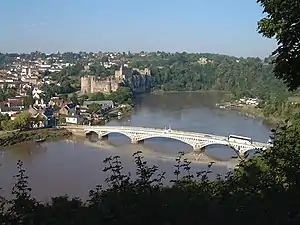Extreme points of Wales
This is a list of the extreme points and extreme elevations in Wales.
Wales

Middle Mouse (Ynys Badrig) as seen from Anglesey (Ynys Mon)
- Northernmost point – Middle Mouse, off Anglesey at 53°26′N 4°26′W
- Northernmost settlement – Llanlleiana, Anglesey at 53°25′N 4°25′W
- Southernmost point – Flat Holm, Cardiff, off Lavernock Point, Vale of Glamorgan at 51°22′N 3°7′W
- Southernmost settlement – Rhoose, Vale of Glamorgan at 51°23′N 3°20′W
- Westernmost point – The Smalls, Pembrokeshire
- Westernmost settlement – Treginnis, Pembrokeshire at 51°52′N 5°18′W
- Easternmost point – Lady Park Wood, near Monmouth, Monmouthshire at 51°49′N 2°39′W
- The easternmost point of North Wales is a section of LLangollen canal at 52°55'49.0"N 2°43'33.4"W
- Easternmost settlement – Chepstow, Monmouthshire at 51°37′N 2°39′W
Wales (mainland)

Chepstow showing border
- Northernmost point – Point of Ayr, Flintshire at 53°21′N 3°19′W
- Northernmost settlement – Talacre, Flintshire at 53°21′N 3°19′W
- Southernmost point – Breaksea Point, Vale of Glamorgan at 51°22′N 3°24′W
- Southernmost settlement – Rhoose, Vale of Glamorgan at 51°23′N 3°20′W
- Westernmost point – Pen Dal-aderyn, Pembrokeshire at 51°51′N 5°19′W
- Westernmost settlement – Treginnis, Pembrokeshire at 51°52′N 5°18′W
- Easternmost point – Lady Park Wood, near Monmouth, Monmouthshire at 51°49′N 2°39′W
- Easternmost settlement – Chepstow, Monmouthshire at 51°37′N 2°39′W
Centre point
The centre point of Wales is dependent on whether only the mainland is used for calculation or outlying islands as well.
One centre point is calculated to be near Cwmystwyth, Devil's Bridge, Ceredigion (52°19′48.791″N 3°45′59.072″W; grid reference SN7972871704)[1]
Elevation extremes

Snowdon seen from Llyn Llydaw
Many points are on, or near sea level, but due to high rainfall, there are no natural dry pieces of land below sea level - see rivers and lakes below.
Rivers and lakes
The largest natural lake in Wales is Llyn Tegid (Bala Lake). Llangorse Lake is second largest.
This is a table of the longest rivers in Wales.[2] Rivers only partly in Wales are included in this table in italics.
| River | Length (miles) |
(km) | |
|---|---|---|---|
| 1 | River Severn | 220 | 354 |
| 2 | River Wye[3] | 155 | 250 |
| 3 | River Usk[4] | 78 | 125 |
| 4 | River Teifi[5] | 76 | 122 |
| 5 | River Towy[6] | 75 | 120 |
| 6 | River Dee[7] | 70 | 112 |
| 7 | River Taff | 40 | 64 |
References
- "Saving the centre of Wales". BBC. 2002-10-24. Retrieved 2010-01-04.
- . Encyclopædia Britannica. 28 (11th ed.). 1911. p. 258 to 270.
- "SSSI Citation River Wye (upper Wye)" (PDF). Natural Resources Wales. Retrieved 14 November 2020.
- "Usk Management Catchment Summary" (PDF). Natural Resources Wales. Retrieved 25 April 2020.
- "River Teifi". Countryside Council for Wales. Archived from the original on 21 February 2014. Retrieved 14 November 2020.
- Davies, John; Jenkins, Nigel; Baines, Menna; Lynch, Peredur I., eds. (2008). The Welsh Academy Encyclopaedia of Wales. Cardiff: University of Wales Press. p. 894. ISBN 978-0-7083-1953-6. Missing or empty
|title=(help) - . Encyclopædia Britannica. 07 (11th ed.). 1911. p. 921.
This article is issued from Wikipedia. The text is licensed under Creative Commons - Attribution - Sharealike. Additional terms may apply for the media files.